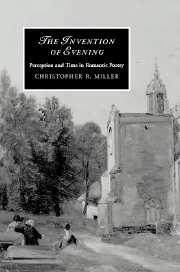Book contents
- Frontmatter
- Contents
- Acknowledgements
- Introduction
- 1 The pre-history of Romantic time
- 2 Coleridge's lyric “moment”
- 3 Wordsworth's evening voluntaries
- 4 Shelley's “woven hymns of night and day”
- 5 Keats and the “Luxury of twilight”
- 6 Later inventions
- Notes
- Bibliography
- Index
- CAMBRIDGE STUDIES IN ROMANTICISM
1 - The pre-history of Romantic time
Published online by Cambridge University Press: 04 May 2010
- Frontmatter
- Contents
- Acknowledgements
- Introduction
- 1 The pre-history of Romantic time
- 2 Coleridge's lyric “moment”
- 3 Wordsworth's evening voluntaries
- 4 Shelley's “woven hymns of night and day”
- 5 Keats and the “Luxury of twilight”
- 6 Later inventions
- Notes
- Bibliography
- Index
- CAMBRIDGE STUDIES IN ROMANTICISM
Summary
In 1746, William Collins and Joseph Warton each wrote odes to evening, which they intended to publish in the same volume. Of the two lyrics, only Collins' is remembered and anthologized today, but the joint nature of these poets' efforts – parallel hymns to a single time of day – is nevertheless a notable fact of literary history. By late century, many other poets had joined the chorus: William Cowper devoted the fourth book of The Task (1785) to describing a winter evening; Charlotte Smith, William Lisle Bowles, and other poets of Sensibility wrote numerous twilight sonnets in the 1780s and 90s; a Cambridge undergraduate named William Wordsworth composed a long topographical excursion entitled An Evening Walk (eventually published in 1793); and in 1796, Samuel Taylor Coleridge, who had been a few years behind Wordsworth at university and admired An Evening Walk, published a volume of poetry inspired by the pensive nocturnal settings of his predecessors.
Evening became the emblematic time of lyric utterance in the eighteenth century, and it will be the work of this chapter to suggest how this came about. What did it mean for Collins and Warton to write odes to Evening? I wish to begin by suggesting that to offer a hymn to Evening was to make a statement of poetic vocation – to describe what Collins called “the Poetical Character.”
- Type
- Chapter
- Information
- The Invention of EveningPerception and Time in Romantic Poetry, pp. 14 - 47Publisher: Cambridge University PressPrint publication year: 2006



